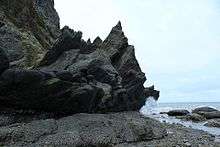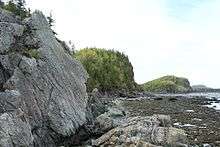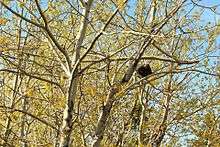Bic National Park
Bic National Park is an 33.2 square kilometres (8,200 acres) national park of Quebec, Canada, located on the south shore of the St. Lawrence River, near the villages of Le Bic and Saint-Fabien, southwest of Rimouski. It was founded on October 17, 1984, and is home to large populations of harbor seals and gray seals. Its highest point is Pic Champlain at 1,140 feet (350 m). Slightly less than half of the park is a coastal marine environment.
| Bic National Park | |
|---|---|
IUCN category II (national park) | |
 | |
| Location | Rimouski / St-Fabien, Rimouski-Neigette Regional County Municipality, Quebec, Canada |
| Nearest city | Rimouski |
| Coordinates | 48°21′N 68°47′W |
| Area | 33.2 km2 (8,200 acres) |
| Established | 7 Nov 1984 |
| Visitors | 166,450 (in 2005 [1]) |
| Governing body | SEPAQ |
The park is owned by the Ministry of Sustainable Development, Environment and Parks of Quebec. It is managed by the Société des établissements de plein air du Québec (SÉPAQ).
Bic National Park is typical of the southern coast of the Gulf of St. Lawrence, containing several characteristics of this region:
- low-flow rivers (la rivière du Sud-Ouest)
- salt marshes (the marsh at Pointe-au-Spruce)
- rocky hills with a very steep northern slope and a relatively gentle southern slope (Pic Champlain, Citadelle, Cap-l'Original, etc.)
History
Human occupation of Bic dates back almost 7,000 years, when Native Americans visited the site: the park's interpretive center displays tools they left behind.
Battle at Baie de Bic



According to Jacques Cartier, the Battle at Baie de Bic happened in the spring of 1534, 100 Iroquois warriors massacred a group of 200 Mi'kmaq camped on Massacre Island in the St. Lawrence River. Baie de Bic was an annual gather place for the Mi'kmaq along the St. Lawrence. Mi'kmaq scouting parties notified the village that the Iroquois attack the evening before the morning attack. They evacuated 30 of the infirm and elderly and about 200 Mi'kmaq vacated their encampment on the shore and retreated to an island in the bay. They took cover in a cave on the island and covered the entrance with branches. The Iroquois arrived at the vacated village in the morning. Finding it vacated, they divided into search parties but failed to find the Mi'kmaq until the morning of the next day.
The Mi'kmaq warriors defended the tribe against the Iroquois assault. Initially, after many had been wounded on both sides, with the rising tide, the Mi'kmaq were able to repulse the assault and the Iroquois retreated to the mainland. The Mikmaq prepared a fortification on the island in preparation for the next assault at low tide. The Iroquois were again repulsed and retreated to the mainland with the rising tide. By the following morning, with low tide the Iroquois made their final approach. They had prepared burning arrows which burned down the fortification and wiped out the Mi'kmaq. Twenty Iroquois were killed and thirty wounded in the battle. The Iroquois divided into two companies to return to their canoes on the Bouabouscache River.[2][3]
No French lord came to live here during the period of New France, but after the Battle of Quebec in 1759, an English lord named Campbell settled there.
In the decades that followed, a maritime pilot post was established at Bic Island, opposite the park. It remained there until 1905, when it was officially transferred to Pointe-au-Père. The pilots had meanwhile settled on the banks of the St. Lawrence River, where they undertook subsistence farming.
At the end of the 19th century, several English villagers built cottages and country houses in the area of the park. Many of these homes are still standing today, although ownership has passed to the park. Among them are the Lyman Cottage, Feindel Cottage, and Wootton House which are on the shores of Anse à l'Original (on le Chemin du Nord trail).
From the late 1970s, preparations began to allow the formal establishment of the park, in 1984. The park's management was handed over to Société des établissements de plein air du Québec (SÉPAQ) in 1999, by the same act which established Bic as a National park.
Hikes
| Trail | Length | Difficulty |
|---|---|---|
| Le Contrebandier The Smuggler |
1.1 km (0.7 mi) | Easy |
| Le Miquelon | 1.9 km (1.2 mi) | Easy |
| Les Escaliers The Stairs |
0.9 km (0.6 mi) | Difficult |
| La Pinède The Pinewood |
1.0 km (0.6 mi) | Difficult |
| Le Scoggan | 2.9 km (1.8 mi) | Intermediate |
| Le Sentier archéologique The Archaeological Trail |
0.2 km (0.1 mi) | Easy |
| Le Chemin-du-Nord The North Road |
4.9 km (3.0 mi) | Easy |
| Le Pic-Champlain The Champlain Peak |
3.0 km (1.9 mi) | Intermediate |
| Les Murailles The Walls |
4.5 km (2.8 mi) | Difficult |
| La Citadelle The Citadel |
4.6 km (2.9 mi) | Intermediate |
| Les Anses The Handles |
1.4 km (0.9 mi) | Intermediate |
Bicycle Trails
| Trail | Length | Difficulty |
|---|---|---|
| Le Portage The Portage |
4.0 km (2.5 mi) | Easy |
| La Grève |
5.0 km (3.1 mi) | Easy |
| La Pointe-aux-Épinettes Spruce Point |
0.7 km (0.4 mi) | Easy |
| La Coulée | 5.0 km (3.1 mi) | Intermediate |
References
- "Communiqué de presse: Québec investit 1,55 M$ dans la région du Bas-Saint-Laurent" (in French). Ministère du Développement durable, de l'Environnement et des Parcs. 2008-08-13. Archived from the original on 2011-09-27. Retrieved 2010-07-22.
- Cartier, second voyage, CL, IX
- Île du Massacre, Rimouski, QC : Battle between Mi'kmaq and Iroquois c. 1534 Archived January 19, 2012, at the Wayback Machine
- This article was initially translated from the French Wikipedia.